HEAD INJURIES
HEAD INJURIES
Head injuries are common in everyday life, and according to the data, they are the leading cause of disability and death among the injured.
Head injuries most often occur in traffic accidents, falls from heights, falls on hard or sharp surfaces, falls down stairs, fights, direct blows to the head, falls of heavy objects on the head, sports activities, diving, firearms injuries.
.
They are common in young children, the elderly due to instability in movement due to chronic diseases, in people suffering from epilepsy / epilepsy, people who consume alcohol or narcotics.
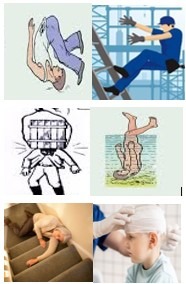

PICTURES: MECHANISMS OF HEAD INJURIES
TRAFFIC ACCIDENTS, FALLS FROM MOTORCYCLES OR BICYCLES
FALL TO THE HEAD FALL FROM A HEIGHT FALL OF AN OBJECT TO THE HEAD OF A DIVING INJURY
PADOVI U KUĆI POVREDE GLAVE KOD DJECE
The most effective and best way of treatment is the prevention of injuries, mostly by motivating people to use protective helmets and seat belts, and protective equipment at work.


PICTURES: PROTECTIVE EQUIPMENT
PROTECTIVE HELMETS FOR RIDING MOTORCYCLES, BIKES, SPORTS SAFETY HELMET FOR WORK
USE OF SEAT BELTS IN CARS AND CAR SEATS FOR CHILDREN
ANATOMICAL PARTS OF THE HEAD
In order to explain the origin and method of first aid for head injuries, we must know that the head anatomically consists of the head (soft tissues-skin and muscles that surround the bones of the head), skull (bone part of the head), sheath and cerebrospinal fluid surround the brain and brain tissue.
ANATOMICAL PARTS OF THE HEAD
FIRST AID ALGORITHM FOR HEAD INJURIES
INITIAL APPROACH AND FIRST AID FOR ALL HEAD INJURIES:
⦁ Check personal safety
⦁ Patient access with patient head fixation
⦁ C - check for pulse, stop large bleeding
⦁ A - opening of the airway with stabilization of the cervical spine
⦁ B - check for the presence of breathing
⦁ D - state of consciousness check
⦁ Place patient in supine position (CONSCIOUS-lying position on flat, UNCONSCIOUS-lateral coma position)
⦁ Call an ambulance
⦁ Wait with the injured until the ambulance arrives and follow vital signs
Procedure for the injured who have a protective mask
In case the injured person has a protective helmet, the HELMET IS NOT REMOVED when providing first aid, unless it is absolutely necessary. Inadequate removal of the helmet can lead to displacement and bending of the cervical spine and additional damage with fatal consequences.
The protective helmet should only be removed if the injured person is unconscious and the airway is blocked, filled with vomit or blood, or if the injured person is not breathing and artificial respiration should be started.
To remove the helmet, two people are needed, during the procedure it is necessary to strengthen the neck and keep it in a neutral position, in order to prevent the movement of the cervical spine.
Suspect a head injury if the injured person has any of the following symptoms:
⦁ Headache
⦁ Loss of consciousness
⦁ Disturbed level of consciousness
⦁ Dizziness
⦁ Nausea
⦁ Vomiting
⦁ Disorientation
⦁ Amnesia, can't remember what happened
⦁ Convulsions- epileptic seizures
⦁ Visible wounds on the head - swelling, hemorrhage, open wounds
⦁ Visible fractures and deformities of skull bones
⦁ Hemorrhages around the eyes or behind the ears
⦁ Clear or pink discharge from the nose or ears
⦁ Uneven pupils, no reaction to light
⦁ Visual impairment
⦁ Speech disorder
⦁ Aggression or agitation of unknown cause
According to the anatomical location, head injuries can also be divided into:
⦁ Violations of the chapter
⦁ Skull injuries
⦁ Injuries to the brain and other structures within the skull
CHAPTER INJURIES
Head injuries are most often head injuries, they bleed heavily, but in principle they do not endanger the life of the injured person, unless they are associated with head or brain bone injuries.
First aid for head injuries:
With a clean gauze, towel or handkerchief, press on the site of injury, to stop the bleeding, taking care that the pressure on the head bones is not too great, because there is always a reasonable suspicion of fracture of the head bones below the site of injury. If a bandage is available, bandage the wound.
HOW TO STOP BLEEDING WHEN CHAPTER INJURY
SKULL INJURIES
Skull injuries involve fractures of the head bones, and are more serious injuries. Bone fractures can be uncomplicated, flat fractures, in which a bone fracture occurs without moving the bone to the brain, or complicated fractures, in which parts of the bone separate, sink into the brain, and can damage the meninges and brain tissue itself. The skin above the fracture may be damaged with an open wound, or without an open wound, with only formed swelling and bruising.
According to the anatomical location they can be divided into:
⦁ Facial bone fractures
⦁ Skull arch fractures
⦁ Fractures of the base of the skull
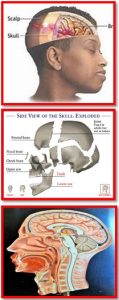
First aid for skull injuries:
As these are more serious injuries, loss of consciousness often occurs in the injured. The injured person should be placed in a lying position, with minimal movements of the neck, because often these injuries are associated with injuries of the cervical spine. If the injured person is unconscious, try to open the airway by lifting the lower jaw, or place the injured person in a lateral, so-called coma position. Notify the ambulance and wait next to the injured.
First aid for facial bone injuries:
The most commonly injured nasal bones (nasal fractures) are accompanied by nosebleeds. Place the injured person in a position with the head tilted forward and squeeze the root of the nose with a handkerchief or gauze. If a bandage is available to wrap the nose, place the bandage in the shape of the so-called. nasal washes .Do not try to straighten the nasal bones !!!
If the bones that make up the eye socket are injured, the injury is also associated with an injury to parts of the eye. Gently cover the eye with gauze, do not try to force the eye of the injured person or rinse it. Cover the eye with gauze, if a bandage is available, wrap it.
If the upper or lower jaw is injured, it is usually associated with a tooth fracture.
If there is an injury to the bone of the upper or lower jaw, stabilize the jaw with a bandage or hand tool (scarf, shawl):
With fractures of the forehead and cheekbones, swelling and bruising usually form. Put a cold compress on the site of the swelling (preferably ice in a bag wrapped in gauze or a tissue, or a cold gel compress, do not put ice directly on the skin). If an injury is open above the fracture, stop the bleeding and bandage.
First aid for skull arch bone injuries:
These injuries require stronger force to occur, they are often associated with more severe brain injuries.
Place the injured person in an appropriate position, if there is an open wound, stop the bleeding with the help of gauze, if there are foreign bodies, do not remove them, try to fix them with gauze, bandage or hand tools. Monitor the consciousness of the injured, breathing, the presence of a pulse.
First aid for skull base injuries:
These injuries can be recognized by the leakage of cerebrospinal fluid from the nose or ear (bloody or clear fluid), and in the later stages by the formation of bruising behind the ear or bruising around the eyes.
Severe and serious injuries. Place the injured person in a supine position, if cerebrospinal fluid leaks from the ear or nose, cover with gauze. Call an ambulance, stay with the injured until the team arrives, monitor vital parameters.
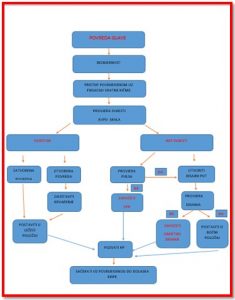
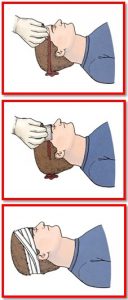
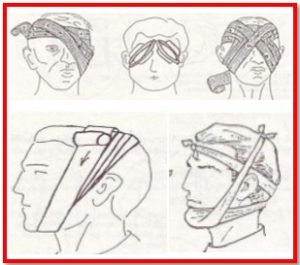
INJURIES OF THE BRAIN AND OTHER STRUCTURES WITHIN THE SKULL
The contents of the cranial fossa consist of the brain, cerebrospinal fluid and blood in the blood vessels. They completely fill the cranial pit, and the enlargement of one, always to the detriment of the other two, is due to the limited enclosed space within the cranial pit.
Concussion
Injuries that do not cause functional brain damage, but short-term loss of consciousness, nausea, vomiting, dizziness, tinnitus, short-term amnesia, so the injured are disoriented and do not remember what happened before the injury.
First aid: Calm the injured, stabilize the cervical spine, monitor vital parameters and call an ambulance, stay with the injured until the arrival of the team.
BRAIN CONCUSION
Brain contusion refers to the formation of a bruise in the brain tissue.
Symptoms include prolonged loss of consciousness or impaired vision, confusion, prolonged amnesia, restlessness, speech problems and limb weakness, vision loss,…
First aid - lateral position, monitor vital parameters, call an ambulance, stay with the injured until the team arrives.
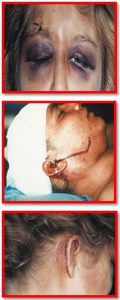
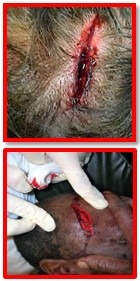
INTRACRANIAL BLEEDING
They are the most serious injuries, often fatal.
They can be divided into:
Bleeding between the dura mater and the skull — EPIDURAL HEMATOMA — occurs most commonly from bleeding from the middle cerebral artery located in the temporal region, and is the result of direct blows to that region. Bleeding is arterial. Symptoms include data on head injury, followed by loss of consciousness, followed by the so-called lucid interval, without any symptoms (from a few minutes to several hours), followed by a sudden worsening - the appearance of severe headache, nausea, vomiting, loss of consciousness, paralysis of one side, to death. EPIDURAL HEMATOMA IS THE MOST URGENT CONDITION FOR HEAD INJURIES, THE ONLY ADEQUATE THERAPY IS TIMELY, QUICK, SURGICAL INTERVENTION.
Bleeding between the dura and the arachnoid meninges from the veins of the brain-SUBDURAL HEMATOMA. As the bleeding is venous, the symptoms may appear late, after a few hours or days, with headache, changes in state of consciousness and neurological outbursts-weakness of one side of the body, slurred speech, to coma.
Bleeding within brain tissue-INTRA-CEREBRAL HEMATOMAS occurs by injury to blood vessels inside the brain. It can be the result of blunt or open head injuries, with the onset of loss of consciousness, and severe neurological outbursts.
First aid for intracranial hemorrhage: stabilize the injured, assess the state of consciousness, place in an adequate position, monitor vital parameters. If breathing stops or the heart stops working, start the resuscitation procedure, call an ambulance as soon as possible, stay next to the injured until the team arrives.
